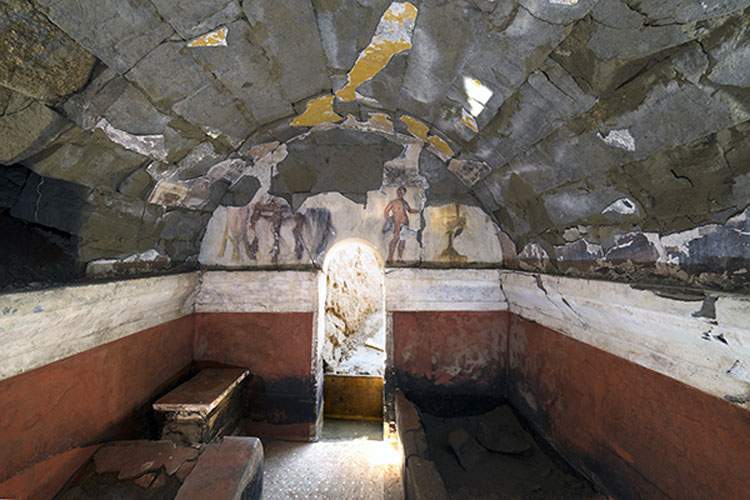Priscilla Munzi, a researcher at the Centre Jean Bérard, and Jean-Pierre Brun, a professor at the Collège de France, have been working since 2001 to restore the necropolis of the ancient city of Cumae to its former glory. The necropolis of Cumae, an ancient city twice the size of Pompeii, is located west of Naples, within what is now the Campi Flegrei Archaeological Park. According to historical sources, Cumae is said to have been the oldest Greek colony in the West, founded by Greeks from Euboea around the middle of the 8th century BC. A painted tomb featuring scenes of a banquet was found during excavation work; the tomb dates back to the 2nd century BC.
One of the scenes depicted on the lunette of the tomb’s entrance wall shows a nude male figure holding a silver jug in his right hand and a chalice in his left hand. On either side of the figure, a small table (trapeza) and several large vessels are depicted, including a chalice crater on a stand, a situla and an amphora on a tripod. On the side walls, landscape scenes are likely to be glimpsed. The decoration is bordered at the top by a floral frieze. The soffit of the vault is yellow, while the walls below the cornice and the three funerary beds are painted red. The theme represented is uncommon for the period and thus offers new insights and study in relation to the evolution of Cumaean wall painting.
The area is characterized by the presence of several tombs built with huge tufa blocks, barrel vaults and monumental facade.
The excavation was made possible by funding from the Ministère de l’Europe et des affaires étrangères, the École française de Rome and the Fondation du Collège de France. The research is part of a MiBAC excavation and research grant and in collaboration with the Campi Flegrei Archaeological Park.
Paolo Giulierini, director of the Phlegraean Fields Archaeological Park, said, “This discovery will enrich the museum, giving new impetus to ongoing investigations in the ancient Phlegraean city and will be useful to the historical and scientific progress of the entire archaeological park.” “The Phlaegrean Fields Archaeological Park systematically supports research, with particular regard to international research,” Giulierini added, “and considers the relationship with the Jean Bérard Center a collaboration of the highest profile. The discovery, which will enrich the museum and the Park, is first and foremost a source of great scientific and historical progress.”
Source: adnkronos
 |
| Discovered at Cumae a 2nd-century B.C. tomb painted with banquet scenes |
Warning: the translation into English of the original Italian article was created using automatic tools. We undertake to review all articles, but we do not guarantee the total absence of inaccuracies in the translation due to the program. You can find the original by clicking on the ITA button. If you find any mistake,please contact us.